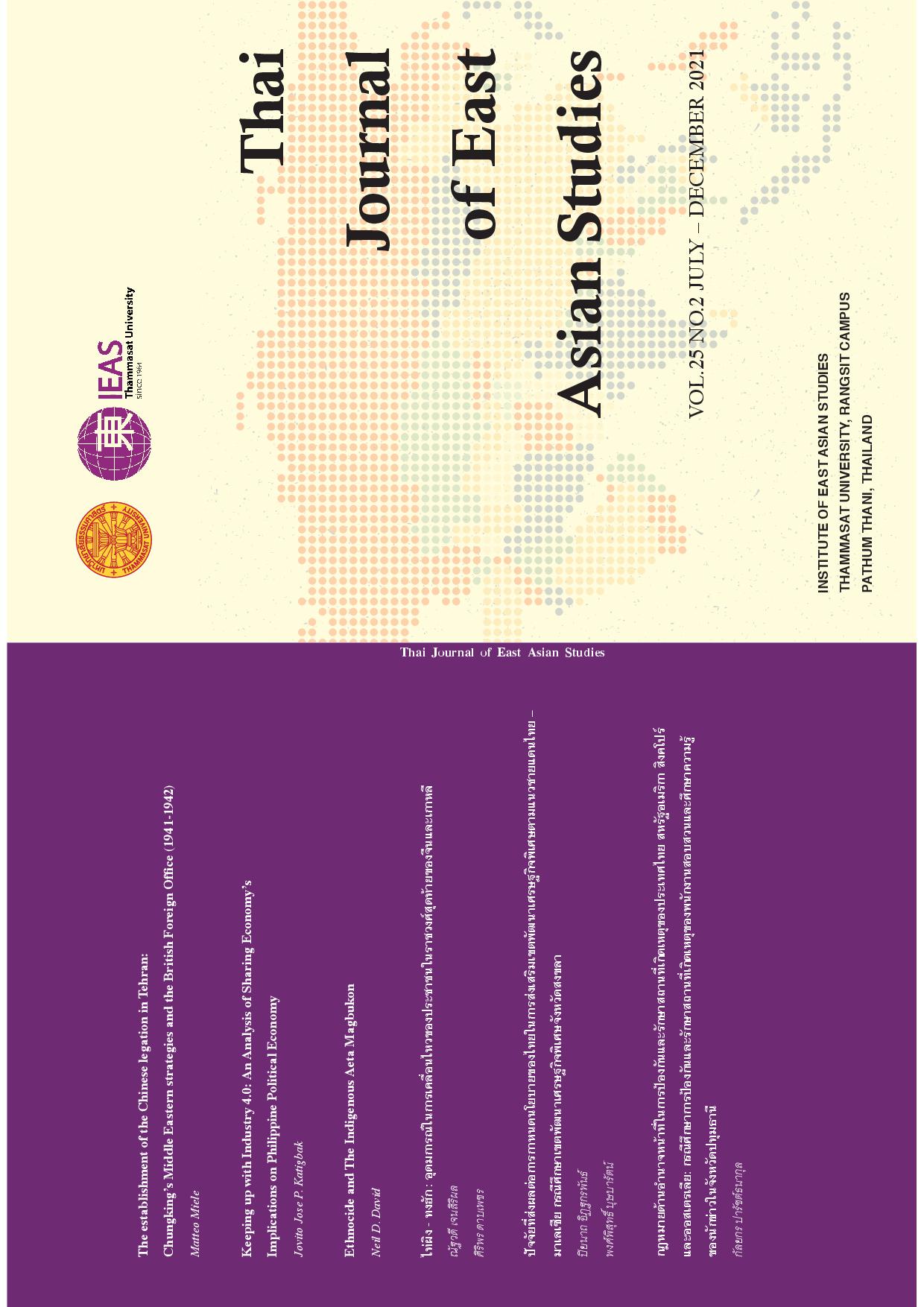Factors in the formulation of Thailand's policy to promote the Thailand – Malaysia Special Border Economic Zone: A case study on the Songkhla Special Economic Development Zone
Keywords:
Border trade, Special Economic Development Zone, Thailand – Malaysia border, policy, Songkhla Special Economic Development ZoneAbstract
This study explains important factors in the formulation of the Special Economic Development Zone policy in Thailand to promote the Thailand – Malaysia Special Border Economic Zone. It focuses on the border area in the Songkhla Special Economic Development Zone. The study uses the complex interdependence concept of Robert O. Keohane and Joseph S. Nye as a framework. The research method is qualitative research by using primary sources and secondary sources to study factors attributing to the formulation of the Songkhla Special Economic Development Zone policy and economic connectivity between the Thailand - Malaysia border.
The study found that these are three external factors attributing to the formulation of the Special Economic Development Zone policy in Thailand. The first factor was the ASEAN regional cooperation framework. The Thai government prepared to enter the ASEAN community in 2015 and connect the economy with neighboring countries. The second factor was the Indonesia – Malaysia –Thailand Growth Triangle (IMT – GT) framework. It resulted in the formulation of border development plans and the promotion of economic connectivity between Thailand and Malaysia. The third factor was the Northern Corridor Economic Region (NCER) development plan of Malaysia. The framework helped to promote border development in Thailand and Malaysia. Therefore, Thailand formulated the Special Economic Development Zone policy in Thailand. It resulted in the determination of the Songkhla Special Economic Zone policy to connect the economy in the southern region of Thailand with Malaysia.
Downloads
References
กรมการค้าต่างประเทศ. (2563). สถิติการค้าชายแดนและการค้าผ่านแดนของประเทศไทย ปี 2562 (ม.ค.–ธ.ค.). http://www.dft.go.th/bts/trade-report
การนิคมอุตสาหกรรมแห่งประเทศไทย. (ม.ป.ป.). โครงการจัดตั้งนิคมอุตสาหกรรมในพื้นที่เขตพัฒนาเศรษฐกิจพิเศษ. https://www.ieat.go.th/sez
คำสั่งคณะรักษาความมั่นคงแห่งชาติที่ 72/2557 เรื่อง แต่งตั้งคณะกรรมการนโยบายเขตพัฒนาเศรษฐกิจพิเศษ. (2557, 27 มิถุนายน). ราชกิจจานุเบกษา. เล่มที่ 131 ตอนพิเศษ 120 ง . หน้าที่ 11–12.
เรวดี แก้วมณี. (ม.ป.ป.). ส่องความคืบหน้ากฎหมายเดินเครื่อง “เขตเศรษฐกิจพิเศษ”. สำนักนโยบายอุตสาหกรรมมหภาค. http://www.fti-samutprakan.com/upload/news/files/12651a4494cb6a65-att.pdf
ศูนย์บริการแบบเบ็ดเสร็จด้านการลงทุนเขตพัฒนาเศรษฐกิจพิเศษสงขลา. (ม.ป.ป.). ความเป็นมา. https://oss.songkhla.go.th/content/information/2
สุณัย ผาสุข. (2539). นโยบายต่างประเทศของไทย: ศึกษากระบวนการกำหนดนโยบายของรัฐบาล พลเอกชาติชาย ชุณหะวัณ ต่อปัญหากัมพูชา (4 สิงหาคม ค.ศ. 1988 ถึง 23 กุมภาพันธ์ ค.ศ. 1991). [วิทยานิพนธ์ปริญญามหาบัณฑิต, จุฬาลงกรณ์มหาวิทยาลัย]. Chulalongkorn University Intellectual Repository (CUIR). http://cuir.car.chula.ac.th/handle/123456789/12483
สำนักงานคณะกรรมการพัฒนาการเศรษฐกิจและสังคมแห่งชาติ. (2559). เขตพัฒนาเศรษฐกิจพิเศษชายแดน. https://www.nesdc.go.th/ewt_dl_link.php?nid=6210
สำนักงานสภาพัฒนาเศรษฐกิจและสังคมแห่งชาติ. (2550). โครงการศึกษาความเป็นไปได้ในการจัดตั้งเขตเศรษฐกิจพิเศษชายแดนบริเวณจังหวัดสงขลา ประเทศไทย-เมืองบูกิตกายูฮีตัม รัฐเกดะห์ ประเทศมาเลเซีย. ศูนย์บริการวิชาการแห่งจุฬาลงกรณ์มหาวิทยาลัย.
สำนักงานคณะกรรมการพัฒนาการเศรษฐกิจและสังคมแห่งชาติ. แผนพัฒนาเศรษฐกิจและสังคมแห่งชาติ ฉบับที่ 7 (พ.ศ. 2535 - 2539). https://www.nesdc.go.th/ewt_dl_link.php?nid=3782
สำนักงานคณะกรรมการพัฒนาการเศรษฐกิจและสังคมแห่งชาติ. แผนพัฒนาเศรษฐกิจและสังคมแห่งชาติ ฉบับที่ 11 (พ.ศ. 2555 --2559). https://www.nesdc.go.th/download/article/article_20160323112431.pdf
สำนักงานคณะกรรมการพัฒนาการเศรษฐกิจและสังคมแห่งชาติ. แผนพัฒนาเศรษฐกิจและสังคมแห่งชาติ ฉบับที่ 12 (พ.ศ. 2560 - 2564). https://www.nesdc.go.th/ewt_dl_link.php?nid=6422
สำนักงานสภาพัฒนาการเศรษฐกิจและสังคมแห่งชาติ. (2564). รายงานความก้าวหน้าการพัฒนาเขตพัฒนาเศรษฐกิจพิเศษ. https://www.nesdc.go.th/ewt_dl_link.php?nid=11189
Bui, T. M. T. (2019). SEZ Development in Cambodia. Thailand and Vietnam and the regional value chains. In Daisuke Hiratsuka (Eds.), EEC Development and Transport Facilitation Measures in Thailand, and the Development Strategies by the Neighboring Countries (pp. 82–117). Bangkok Research Center.
Krainara, C. & Routray J. K. (2015). Cross-border trades and commerce between Thailand and Neighboring countries: policy implications for establishing Special Border Economic Zone. Journal of Borderlands Studies, 30(3), 344 – 363. https://doi.org/10.1080/08865655.2015.1068209
Northern Corridor Implementation Authority (NCIA). (n.d.). Bukit kayu Hitam Special Border Economic Zone. NCER Malaysia.https://www.ncer.com.my/strategic-projects-programmes/strategicinfrastructure/bukit-kayu hitam-special-border-economic-zone/
Lord, M. J. & Tangtrongjita, P. (2014, May 15). Special Border Economic Zone (SBEZ) in the Indonesia–Malaysia-Thailand Growth Triangle (IMT – GT). https://mpra.ub.uni-muenchen.de/61060/1/MPRA_paper_61060.pdf
Keohane, R. O. & Nye, J. S. (1977). Power and interdependence: world politics in transition. Little, Brown, and Company.
Ministry of Transport of Malaysia. (n.d.) port development integrated intermodal transport. https://www.unescap.org/sites/default/files/Malaysia_CBStrengthening%20Transport_March.pdf
The World Bank Group. (2017). Special Economic Zones an Operational Review of Their Impacts. https://openknowledge.worldbank.org/bitstream/handle/10986/29054/P154708-12-07-2017-1512640006382.pdf?sequence=1&isAllowed=y
Downloads
Published
How to Cite
Issue
Section
License
Copyright (c) 2021 Thai Journal of East Asian Studies

This work is licensed under a Creative Commons Attribution-NonCommercial-NoDerivatives 4.0 International License.



